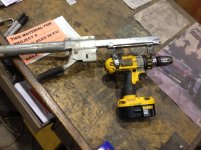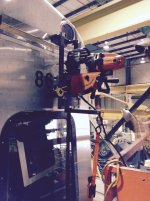chim
Elite Member
I don't have tons of experience with drilling holes, but I'm not entirely without some experience. I can't say I would normally use a pilot for 1/4" or smaller holes. Where I do use a pilot, I go by the advice of an instructor years ago. He said if you use a pilot, use one approx. 1/3 of the desired hole size.
We have a project that has involved drilling in unusual positions and through stainless and high strength alloys. The Superintendent on the project asked if I could come up with something to make life easier for the crew in a couple instances. The first was drilling a 1/4" through a high strength steel part under a train car. The part was at an angle to any reference and the only access was standing in a pit under the car. He said he could really use an upside-down drill press that can drill on an angle. For that I fashioned a "jack" type affair from a bar (load locking bar) in the warehouse. Clamps secure an 18V DeWalt drill to one end. The other end still has a rubber foot that pushes against the concrete in the pit. Works nicely.
Another situation was drilling into the end of the locomotive for a device that mounts on the exterior. It requires two small holes and one large hole. Picture a Mickey Mouse head pattern. The car is stainless and a mag drill won't stick. The material being drilled is two pieces of stainless steel about 3/16" thick and separated nearly an inch of air space. There is a very substantial rain gutter above where the holes go, so I sent a CAD sketch of the plate with the slots to a nearby laser shop and had them cut it out. Then had the guys in our weld shop make an adjustable mounting bracket. It uses the rain gutter at the top and secured via load binder strap on the bottom.
The plate is positioned for one of the holes with the mag drill stuck in the appropriate scribed footprint. The plate has scribed footprints for each of the three holes that automatically position the bits where they belong. An 1-3/8" annular cutter is used for the larger hole. A 3-jaw chuck equipped with a Weldon shank with twist bits is used for the smaller holes. Sounds more difficult than it is.
For the annular cutters we use lube that comes in what looks like a grease gun tube of ear wax. For smaller holes / twist bits we go with Red Lion made by Chromate Industrial.
We have a project that has involved drilling in unusual positions and through stainless and high strength alloys. The Superintendent on the project asked if I could come up with something to make life easier for the crew in a couple instances. The first was drilling a 1/4" through a high strength steel part under a train car. The part was at an angle to any reference and the only access was standing in a pit under the car. He said he could really use an upside-down drill press that can drill on an angle. For that I fashioned a "jack" type affair from a bar (load locking bar) in the warehouse. Clamps secure an 18V DeWalt drill to one end. The other end still has a rubber foot that pushes against the concrete in the pit. Works nicely.
Another situation was drilling into the end of the locomotive for a device that mounts on the exterior. It requires two small holes and one large hole. Picture a Mickey Mouse head pattern. The car is stainless and a mag drill won't stick. The material being drilled is two pieces of stainless steel about 3/16" thick and separated nearly an inch of air space. There is a very substantial rain gutter above where the holes go, so I sent a CAD sketch of the plate with the slots to a nearby laser shop and had them cut it out. Then had the guys in our weld shop make an adjustable mounting bracket. It uses the rain gutter at the top and secured via load binder strap on the bottom.
The plate is positioned for one of the holes with the mag drill stuck in the appropriate scribed footprint. The plate has scribed footprints for each of the three holes that automatically position the bits where they belong. An 1-3/8" annular cutter is used for the larger hole. A 3-jaw chuck equipped with a Weldon shank with twist bits is used for the smaller holes. Sounds more difficult than it is.
For the annular cutters we use lube that comes in what looks like a grease gun tube of ear wax. For smaller holes / twist bits we go with Red Lion made by Chromate Industrial.



